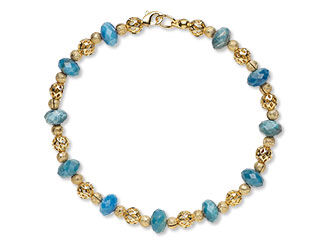Apatite Meaning and Properties
Apatite History
Apatite is actually the mineral that makes up the teeth and bones of all vertebrate animals. In 1786, the mineral was given its name by German geologist Abraham Gottlob Werner. The name apatite comes from the Greek word apate ("to deceive"), a nod to its remarkable tendency to resemble more well-known gemstones. Throughout history, apatite's vibrant colors and crystal forms have often led it to be mistaken for gems like tourmaline, olivine, peridot, topaz and beryl —showcasing its surprising beauty and versatility.
In manufacturing applications, apatite is a source of phosphorus for fertilizer. Moon rocks brought back to earth by Apollo astronauts in the late 1960s and early 1970s were found to contain traces of apatite.
Unlock the vibrant world of apatite! In this video, we explore the history, properties and metaphysical meaning of this captivating gemstone—plus, we’ll show you how to create a beautiful pendant necklace using apatite in one of its many stunning forms.

What are the Metaphysical Properties of Apatite?
Apatite properties are closely tied to personal growth and mental clarity. Aligned with the zodiac sign Gemini, this gemstone is believed to curb appetite (hunger) while enhancing insight, creativity and learning. Apatite properties are also thought to include sharpening focus and concentration, supporting intellect and encouraging acceptance and unconditional love—both for oneself and from others.
What is Apatite Made From?
A common phosphate mineral, apatite is found in igneous, sedimentary and metamorphic rock, in phosphorite and in some hydrothermal veins and in iron-rich igneous deposits along with feldspar, quartz and iron ores. Apatite deposits come from Myanmar (Burma), Brazil, India, Kenya, Madagascar, Norway, Sri Lanka, South Africa, Mexico, Canada and the United States.
There are three minerals that actually contribute to apatite, which is the reason for the varied colors and shades of this stone. Apatite is calcium phosphate combined with fluorine, chlorine or hydroxyl. These three minerals are usually found in every specimen, but some specimens have been known to have 100% of one or the other. It is often hard to spot the difference between the three minerals in hand samples of this stone. Therefore, they are often considered together in apatite.
- Mineral Information: Basic fluori- and chloro-calcium phosphate
- Chemical Composition: Ca5(PO4)3 + (F, Cl, or OH)
- Color: Colorless, pink, yellow, green, blue, violet, brown, purple
- Hardness: 5 (Mohs)
- Specific Gravity: 3.17 - 3.23
- Refractive Index: 1.628 - 1.65
How Do You Clean Apatite?
This stone is fragile and very sensitive to chemicals, abrasives, heat, acids and ammonia. Never use a steamer, hot water or ultrasonic cleaners with this gemstone. Mild soap and room temperature tap water are best, with a soft cloth to prevent scratching the surface or diminishing the luster of the gemstone.
Apatite FAQs
Q: Where is apatite sourced from?
A: Apatite is found worldwide, with major sources including Brazil, Mexico, Canada, Madagascar and Myanmar. Each location can produce apatite in different colors, with neon blue-green varieties from Madagascar and Brazil being especially prized in jewelry.
Q: How transparent or translucent is apatite?
A: Apatite can range from transparent to translucent. The most gem-quality apatite, often used in jewelry, is usually transparent with good clarity, though inclusions are common. Lower-grade apatite tends to be more cloudy or opaque.
Q: Is apatite treated in any way?
A: Yes, many apatite gems—especially vivid blue or green varieties—are heat-treated to enhance color and clarity. This is a common and accepted practice in the gem world, but untreated stones can also be found on the market.
Q: Is apatite really used in dental products and bone grafts?
A: Yes! A form of apatite called hydroxyapatite is a natural component of human bones and teeth. Synthetic versions are widely used in dental pastes, enamel repair and bone grafts due to their excellent biocompatibility.
Designing with Apatite
Apatite’s vibrant colors evoke the beauty of tropical waters. Its soothing brilliance pairs especially well with silver beads and pearls, creating eye-catching designs. With a Mohs hardness of 5—comparable to tooth enamel—apatite is best suited for low-impact jewelry like earrings, pendants and necklaces. This rare gemstone can display chatoyancy, a shimmering cat’s-eye effect that adds even more intrigue to its striking hues.
A Few Design Inspirations to Get You Started
Shop for Apatite
**Please note that all metaphysical or healing properties listed are collected from various sources. This information is offered as a service and not meant to treat medical conditions. Fire Mountain Gems and Beads® does not guarantee the validity of any of these statements.
How did you like this resource? Your feedback helps us provide resources that matter to you most.
Copyright Permissions
All works of authorship (articles, videos, tutorials and other creative works) are from the Fire Mountain Gems and Beads® Collection, and permission to copy is granted for non-commercial educational purposes only. All other reproduction requires written permission. For more information, please email copyrightpermission@firemtn.com.






